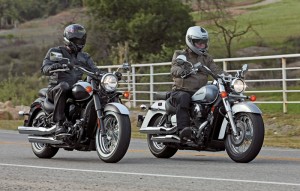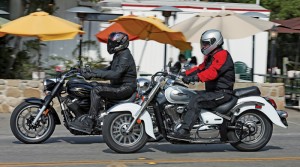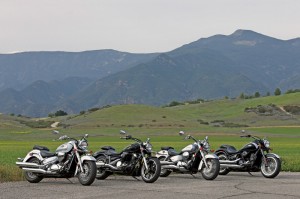My favorite comfort foods, heart-warming and artery-clogging classics like mac-and-cheese, buttermilk biscuits and pulled-pork barbecue, are straightforward and uncomplicated, each prepared with a short list of ingredients and easy techniques. But many cooks have been fooled by such simplicity, following recipes dutifully but ending up with bland results. The artistry, the ability to create a dish that’s just right, is a matter of feel and balance.
Cruisers also follow a basic recipe, one steeped in tradition. Must-have ingredients typically include a rumbling V-twin with prominent cooling fins (even if it’s liquid-cooled), a hands-and-feet-forward riding position and a low seat height. Beyond these essentials it becomes a matter of taste, with engine size, presence or absence of touring equipment and degree of customization, among other things, depending on rider preference. Cruisers are rarely about performance. Lean angles and quarter-mile times are irrelevant. But they need to have the right sound and feel (a hefty dose of torque always helps), and, above all, they have to look right.

In the past, we’ve compared touring cruisers, heavyweight cruisers, factory-custom cruisers and performance cruisers. For this comparison test we’ve gone back to basics. We gathered four middleweight cruisers from Japan—Honda Shadow Aero, Kawasaki Vulcan 900 Classic, Star V Star 950 and Suzuki Boulevard C50 Special Edition—that are essentially in base-model trim. The only upgrades are two-tone paint on the Honda ($300) and two-tone paint and cast wheels on the Suzuki ($400). These are general-purpose cruisers with as-tested prices below $9,000. They’re powered by V-twins with modest engine displacements, they have traditional cruiser riding positions and their seat heights range from 25.9 to 27.6 inches.
We rode this foursome like they’d typically be ridden: around town, up and down the freeway, and at a leisurely pace on back roads. Since none offer wind protection or luggage, we didn’t venture more than an hour or two from home base and we (mostly) kept our speed below 70 mph—any faster and the windblast became exhausting. For traveling longer distances or with a passenger, the Kawasaki, Star and Suzuki are also available as touring models with windshields, saddlebags and passenger backrests; Honda offers those items as factory accessories but not as part of a touring-specific model.
The main section of this test focuses on how the four cruisers compare to each other. One-page sidebars and side-by-side spec charts provide details on each model.

READY TO RUMBLE
Defining the term “middleweight” with precision is like shooting pool with a rope—an exercise in futility. The range in engine displacement between these four bikes is less than 200cc, yet each manufacturer has staked out its own position along the continuum, from 745cc on the Honda Shadow to 942cc on the Star V Star, with the Suzuki Boulevard (805cc) and Kawasaki Vulcan (903cc) in between. All four are fuel-injected, all four run on regular unleaded and all but the Star are liquid-cooled. Their engines are tuned for low-end torque, in the 2,000-5,000 rpm zone where cruisers spend most of their time. Jett Tuning’s dyno reveals that peak torque occurs within a narrow range, from 3,300-3,800 rpm, with maximum values increasing lockstep with displacement, from 44.7 lb-ft on the Honda to 55.4 lb-ft on the Star.
Although the Honda has the lowest torque, as the lightest bike here by 48-60 pounds it doesn’t feel like the underdog.
As important as low-end torque is a cruiser’s loping syncopation, the distinctive rumble that gives it character. Like displacement, no two V angles are the same, from as narrow as 45 degrees on the Suzuki to as wide as 60 degrees on the Star. Three of the four—the Honda, Kawasaki and Star—use single-pin crankshafts to achieve a throbbing feel, whereas the Suzuki uses an offset dual-pin crank for smoother running.
Vibration isn’t excessive on any, but by the time you reach 70 mph in top gear, all of them feel a bit strained and buzzing creeps into your hands, feet and seat. None have excessively loud exhausts, but the Honda and Suzuki have the deepest, richest tone. Throttle response is good all around, and lash from the driveline—a shaft on the Honda and Suzuki, a belt on the Kawasaki and Star—is minimal.

Since cruisers typically operate within a narrow rev range and at modest speeds, this quartet makes do with 5-speed transmissions and all have cable-actuated clutches with thumbwheel-adjustable levers. The Kawasaki, Star and Suzuki have floorboards and heel-toe shifters, while the Honda has footpegs and a conventional toe shifter. Like most Japanese bikes, all of them shift smoothly and have good clutch action. The only problem we experienced is limited room between the floorboard and toe shifter on the Kawasaki and Star when wearing chunky boots, as many cruiser riders do.
Up front, all utilize a non-adjustable conventional fork with 41mm stanchions. The Kawasaki, Star and Suzuki have single rear shocks that are hidden for a hardtail look, while the Honda has dual rear shocks, and spring preload is adjustable. As with most cruisers, these bikes have more front suspension travel than rear, which helps keep seat height low. Compliance is generally good across the board, but the Kawasaki and Suzuki have noticeably better damping. The Honda’s exposed dual shocks make it easy to crank up preload to compensate for our testers’ above-average weight, improving ride quality considerably.
All four bikes have single-disc front brakes with two-piston pin-slider calipers. The Kawasaki and Star use disc brakes for the rear, and the Honda and Suzuki use drums. Four fingers on the lever and good pressure on the rear pedal are required to get decent braking power out of any of them, and none offer much feel. Although the Honda’s rear drum feels like a sponge, its front brake is the best of the bunch. Only the Star and Suzuki have adjustable front brake levers.
The sharpest distinctions between these cruisers are in terms of ergonomics and styling, two qualities that are very much in the inseam and eye of the beholder. We have a five-inch range in inseam among our testers (from 29-34 inches), and that affects how each bike fits us. As the smallest bike, the Honda Shadow has the most cramped cockpit. Its narrow buckhorn handlebar reaches back toward the rider at an awkward angle, and the footpegs limit legroom. Like the others, the Honda has a wide, dished seat that is soft but not very supportive, contributing to butt burn within a half-hour. Similar to the Honda, the Kawasaki Vulcan also has a small cockpit, both can give the impression of sitting on the tank rather than behind it. The Kawi’s beach cruiser-style handlebar is positioned close to the rider and the grips are high. Although it has the most comfortable seat of the four, the Kawasaki’s thickly padded one-piece rider/passenger seat forces the rider closer to the tank. The Star has a tiller-style handlebar that is the widest of them all and is well positioned. Likewise, the Suzuki’s beach cruiser-style handlebar offers a comfortable reach and grip. Both the Star and Suzuki have the roomiest ergonomics, which larger/taller riders will appreciate.

With their white/silver paint jobs, generous use of chrome and full fenders, the Honda and Suzuki have the most conventional styling. The Kawasaki takes the old-school cool route with matte black/white paint, spoked wheels and whitewall tires. The Star has the most distinctive styling, with bobbed fenders, custom-looking black/silver wheels and gold graphics on the stretched tank. All give the rider an unobstructed view of the road, with instrumentation confined to consoles atop the tank that include large analog speedometers, small LCD displays (clock, odometer and tripmeter) and indicator lights. The Kawasaki and Suzuki have fuel gauges but the others do not, and the Suzuki adds a gear position indicator.
AT THE END OF THE DAY
Some cruisers are about bling, others are about raw power and others still are about touring ability. These four are generalists, not specialists. With their V-twins, clamshell riding positions and low seat heights, they have the basic ingredients of traditional cruisers, and as middleweights, they aren’t too big, too powerful or too expensive. They’re all fairly close in terms of engine performance (relative to displacement), shifting, suspension compliance and braking power, and their prices span a range of just $259.
But there are differences in size, with the Honda weighing just 560 pounds compared to 608-620 pounds for the others. It also has the lowest seat height (25.9 inches compared to 26.6-27.6 inches). There are also differences in fuel economy, fuel capacity and range (see specs). Notably, the Star and Suzuki roll on cast wheels with tubeless tires, so that flats can be repaired quickly and easily. Since none of these bikes has a centerstand, getting a flat on the Honda or Kawasaki, which have spoked wheels with tube-type tires, can be a challenging and costly ordeal.
When it comes down to it, the Suzuki Boulevard C50 takes the basic cruiser recipe and produces the most satisfying overall package. It is stylish, runs smoothly, has a satisfying exhaust note, handles the best, has good suspension compliance, offers decent cornering clearance and includes extras like a fuel gauge and gear position indicator. The Star V Star 950 is the best-looking bike—often the most important consideration—but it has the most unwieldy handling and too little cornering clearance. With its retro-chic styling, the Kawasaki Vulcan 900 Classic is also a looker, and, thanks to their larger displacements, it and the Star make the most horsepower and torque. The Kawi has the most comfortable seat and among the best suspension compliance, but the seating position is awkward. The Honda Shadow Aero is the smallest and lightest—an advantage for smaller riders but not for others—but with its buckhorn handlebar and footpegs, the seating position is an acquired taste. Though it has the best fuel economy (51.5 mpg), it has the smallest fuel tank (3.7 gallons), limiting range to less than 200 miles.
* This is the lead article in a four-motorcycle comparison titled Main Street Middleweights, which was published in the June 2013 issue of Rider magazine. To read the individual bike reviews, click on the links below:
- 2013 Middleweight Metric Cruiser Comparo (main article)
- Suzuki Boulevard C50 Special Edition
- Star V Star 950
- Honda Shadow Aero
- Kawasaki Vulcan 900 Classic








Just traded my 99 Kawa Vulcan 800 Classic with 20K miles for a 2013 Suz. C50 with 4600 miles. Love this C50 and its shaft drive instead of a chain. The C50 has more torque, but both bikes cruise well at 75-80 mph. Either will hit 100 without undue strain. Handling is similar, but the C50 is hardly broken in yet. And it has mag wheels & tubeless tires-oh joy!